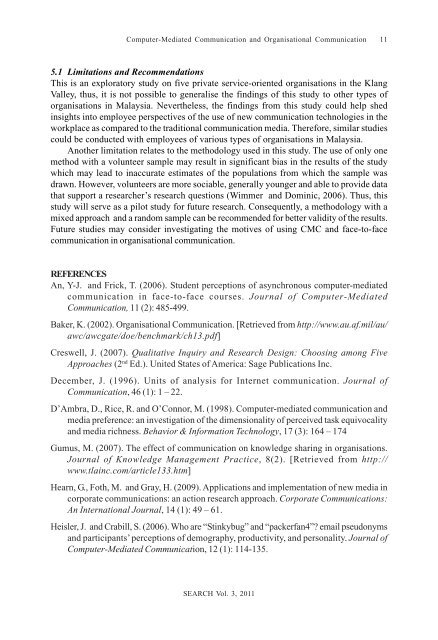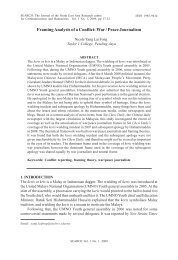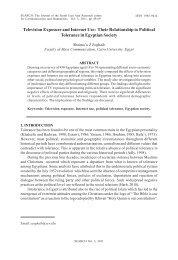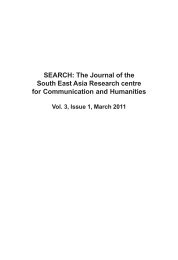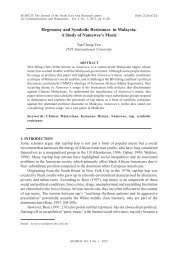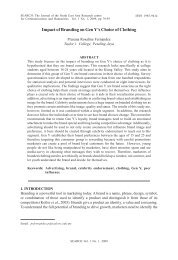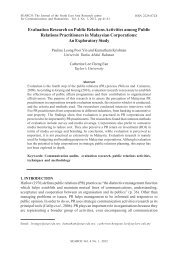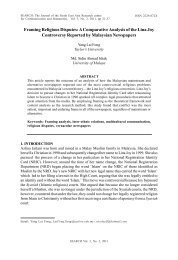Computer-Mediated Communication and Organisational ...
Computer-Mediated Communication and Organisational ...
Computer-Mediated Communication and Organisational ...
You also want an ePaper? Increase the reach of your titles
YUMPU automatically turns print PDFs into web optimized ePapers that Google loves.
<strong>Computer</strong>-<strong>Mediated</strong> <strong>Communication</strong> <strong>and</strong> <strong>Organisational</strong> <strong>Communication</strong> 115.1 Limitations <strong>and</strong> RecommendationsThis is an exploratory study on five private service-oriented organisations in the KlangValley, thus, it is not possible to generalise the findings of this study to other types oforganisations in Malaysia. Nevertheless, the findings from this study could help shedinsights into employee perspectives of the use of new communication technologies in theworkplace as compared to the traditional communication media. Therefore, similar studiescould be conducted with employees of various types of organisations in Malaysia.Another limitation relates to the methodology used in this study. The use of only onemethod with a volunteer sample may result in significant bias in the results of the studywhich may lead to inaccurate estimates of the populations from which the sample wasdrawn. However, volunteers are more sociable, generally younger <strong>and</strong> able to provide datathat support a researcher’s research questions (Wimmer <strong>and</strong> Dominic, 2006). Thus, thisstudy will serve as a pilot study for future research. Consequently, a methodology with amixed approach <strong>and</strong> a r<strong>and</strong>om sample can be recommended for better validity of the results.Future studies may consider investigating the motives of using CMC <strong>and</strong> face-to-facecommunication in organisational communication.REFERENCESAn, Y-J. <strong>and</strong> Frick, T. (2006). Student perceptions of asynchronous computer-mediatedcommunication in face-to-face courses. Journal of <strong>Computer</strong>-<strong>Mediated</strong><strong>Communication</strong>, 11 (2): 485-499.Baker, K. (2002). <strong>Organisational</strong> <strong>Communication</strong>. [Retrieved from http://www.au.af.mil/au/awc/awcgate/doe/benchmark/ch13.pdf]Creswell, J. (2007). Qualitative Inquiry <strong>and</strong> Research Design: Choosing among FiveApproaches (2 nd Ed.). United States of America: Sage Publications Inc.December, J. (1996). Units of analysis for Internet communication. Journal of<strong>Communication</strong>, 46 (1): 1 – 22.D’Ambra, D., Rice, R. <strong>and</strong> O’Connor, M. (1998). <strong>Computer</strong>-mediated communication <strong>and</strong>media preference: an investigation of the dimensionality of perceived task equivocality<strong>and</strong> media richness. Behavior & Information Technology, 17 (3): 164 – 174Gumus, M. (2007). The effect of communication on knowledge sharing in organisations.Journal of Knowledge Management Practice, 8(2). [Retrieved from http://www.tlainc.com/article133.htm]Hearn, G., Foth, M. <strong>and</strong> Gray, H. (2009). Applications <strong>and</strong> implementation of new media incorporate communications: an action research approach. Corporate <strong>Communication</strong>s:An International Journal, 14 (1): 49 – 61.Heisler, J. <strong>and</strong> Crabill, S. (2006). Who are “Stinkybug” <strong>and</strong> “packerfan4”? email pseudonyms<strong>and</strong> participants’ perceptions of demography, productivity, <strong>and</strong> personality. Journal of<strong>Computer</strong>-<strong>Mediated</strong> <strong>Communication</strong>, 12 (1): 114-135.SEARCH Vol. 3, 2011


